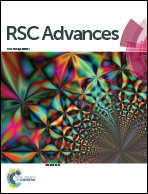Determination of the STM tip-graphene repulsive forces by comparative STM and AFM measurements on suspended graphene†
Abstract
Graphene grown by chemical vapour deposition is transferred on top of flat gold nanoislands and characterized by scanning tunnelling microscopy (STM) and atomic force microscopy (AFM). Graphene bubbles are formed with lateral dimensions determined by the size and shape of nanoislands. These graphene bubbles can be squeezed during STM imaging using bias voltages of less than 250 mV and tunnelling currents of 1 nA. Similarly, the graphene suspended over gold nanovoids is deflected 4–5 nm by the STM tip when imaging at low bias voltages (U = 30 mV). Nanoindentation measurements performed by AFM show that the squeezing of graphene bubbles occurs at repulsive forces of 20–35 nN, and such forces can result in deflections of several nanometres in suspended graphene parts, respectively. Comparing the AFM and STM results, this study reveals that mechanical forces of the order of 10−8 N occur between the STM tip and graphene under ambient imaging conditions and typical tunnelling parameters.



 Please wait while we load your content...
Please wait while we load your content...